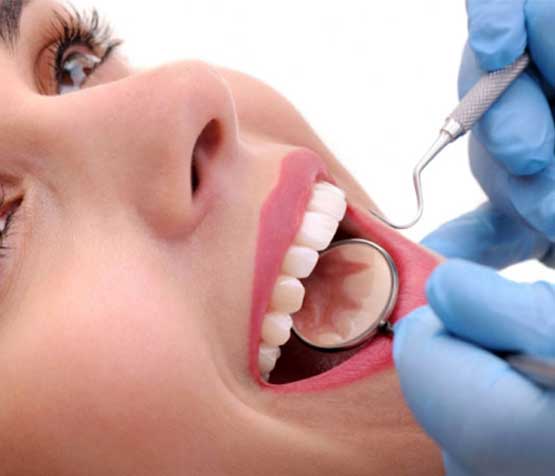At Peace Periodontics, our goal is to restore the health of your gums and improve your overall dental health. Treatment of periodontal disease depends on the type of periodontal disease we are treating. Your periodontal consultation is used to provide a diagnosis and treatment plan that best suits your needs.

Non-Surgical Treatment Options
Non-surgical treatment for periodontal disease includes:
- Scaling: Scaling removes tartar and bacteria from your tooth surfaces and beneath your gums. It may be performed using instruments or an ultrasonic device.
- Root Planing: Root planing smoothes the root surfaces, discouraging the further buildup of tartar and bacterial endotoxin.
- Antibiotics: Your periodontist may recommend using topical or oral antibiotics to help control bacterial infection. Topical antibiotics can include antibiotic mouth rinses or insertion of gels containing antibiotics in the space between your teeth and gums or directly into the pockets after a deep cleaning. The use of oral antibiotics may be necessary to eliminate infection-causing bacteria.
Surgical Treatment for Advanced Periodontal Disease
If you have advanced periodontitis, your gum tissue may not respond to nonsurgical treatments. In that case, periodontitis treatment may require dental surgery, such as:
- Flap Surgery (Pocket Reduction Surgery): With flap surgery, your periodontist makes tiny incisions in your gum so that a section of gum tissue can be lifted back, exposing the roots for more effective scaling and root planing. Because periodontitis often causes bone loss, the underlying bone may be re-contoured before the gum tissue is sutured back in place. After you heal, it’s easier to clean these areas and maintain healthy gum tissue.
- Soft Tissue Graft: When you lose gum tissue to periodontal disease, your gumline recedes. You may need to have some of the damaged soft tissue reinforced. This is usually done by removing a small amount of tissue from the roof of your mouth (palate) or another donor source and then attaching it to the affected site. This procedure can help reduce further gum recession, cover exposed roots and give your teeth a more pleasing appearance.
- Bone Grafting: This procedure is performed when periodontitis has destroyed the bone surrounding your tooth root. The graft may be composed of small fragments of your own bone, or the bone may be synthetic or donated. The bone graft helps prevent tooth loss by holding your tooth in place. It also serves as a platform for the regrowth of natural bone.
- Guided Tissue Regeneration: This allows the regrowth of bone that was destroyed by bacteria. In one approach, your periodontist places a special piece of bio-compatible fabric between existing bone and your tooth. The material prevents unwanted tissue from entering the healing area, thus allowing the bone to grow back instead.
- Enamel Matrix Derivative Application: This technique involves applying a special gel to a diseased tooth root. This gel contains the same proteins found in developing tooth enamel and stimulates the growth of healthy bone and tissue
Your Treatment Plan
Our Dental Team carefully examine your diagnostic records and create a treatment plan that best suits your needs. If you have been referred to see a periodontist of if you suspect you have gum disease, we invite you to contact our office to schedule your appointment.
To learn more about Periodontitis, we invite you to contact Peace Periodontics to schedule a consultation appointment.
Featured Periodontal Services
Testimonial
Contact Us
Working Hours
| Monday: | 8:00 am – 5:00 pm |
| Tuesday: | 8:00 am – 5:00 pm |
| Wednesday: | 8:00 am – 5:00 pm |
| Thursday: | 8:00 am – 5:00 pm |
| Friday: | 8:00 am – 2:00 pm |
| Saturday’s, Sunday’s & Statutory Holidays: |
Closed |
